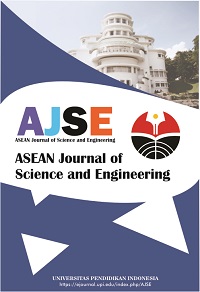Design Thinking to Enhance E-Commerce Accessibility for Blind Users in Indonesia
Abstract
Keywords
Full Text:
PDFReferences
Gatta, S.A., and Ishola, N.A. (2022). Effect of cooperative learning strategy on students academic performance in commerce in secondary schools. ASEAN Journal of Economic and Economic Education, 1(2), 111-120.
Soltani, M. R. (2024). Adapting to the new normal: E-commerce and the evolution of consumer behavior in the pandemic era and beyond. Journal of Security and Strategic Affairs, 1(4), 28-42.
Zou, T., and Cheshmehzangi, A. (2022). ICT adoption and booming e-commerce usage in the COVID-19 era. Frontiers in Psychology, 13, 916843.
Jannah, M., Mahmuda, Z., & Alankrita, A. (2025). The Digital Economy Boom: How E-Commerce is Reshaping Indonesia’s Market. Indonesia Discourse, 2(1), 1-26.
Shahroni, N., Minghat, A.D., and Mustakim, S.S.B. (2022). Competency index of technical vocational education and training (TVET) instructors for 4.0 industrial revolution. ASEAN Journal of Educational Research and Technology, 1(2), 155-162.
Shahroni, N., Minghat, A.D., and Mustakim, S.S.B. (2022). Methodology for investigating competency index of technical vocational education and training (TVET) instructors for 4.0 industrial revolution. ASEAN Journal for Science Education, 1(1), 49-62.
Anwar, N.B.B., and Minghat, A.D. (2024). Industrial engineering students’ readiness towards industrial revolution 4.0 at technical and vocational university: Literature review. ASEAN Journal for Science Education, 3(1), 95-112.
Bachtiar, A. M., Dharmayanti, D., and Febriana, F. (2020). Analysis of interaction design in the Braille Al-Qur’an learning app for visually impaired people. Journal of Engineering Science and Technology, 15, 1–9.
Vo, J., Hewitt, D. H., and He, Y. (2023). Web accessibility: A revisit of U.S. State and territory COVID-19 websites After Two Years. Proceedings of the Human Factors and Ergonomics Society Annual Meeting, 67(1), 1084–1089.
Parthasarathy, P., Adler, R. F., Kletenik, D., Joshi, S., and Mittal, A. M. (2025). Skill, will, or both? Understanding digital inaccessibility from accessibility professionals’ viewpoint. Proceedings of the Extended Abstracts of the CHI Conference on Human Factors in Computing Systems, 1–9.
Reuschel, W., McDonnall, M., and Burton, D. (2023). The accessibility and usability of online job applications for screen reader users. Journal of Visual impairment and blindness, 117(6), 479-490.
Hossain, M. A., Hassan, M., Khatoon, R., Kamruzzaman, M., and Debnath, A. (2020). Technological innovations to overcome cross-border e-commerce challenges: Barriers and Opportunities. Journal of Business and Management Studies, 2(2), 70-81.
Botelho, F. H. F. (2021). Accessibility to digital technology: Virtual barriers, real opportunities. Assistive Technology, 33(sup1), 27–34.
Micheli, P., Wilner, S. J. S., Bhatti, S. H., Mura, M., and Beverland, M. B. (2019). Doing design thinking: Conceptual review, synthesis, and research agenda. Journal of Product Innovation Management, 36(2), 124–148.
Ara, J., and Sik-Lanyi, C. (2025). Automated evaluation of accessibility issues of webpage content: Tool and evaluation. Scientific Reports, 15(1), 9516.
Clarkson, J., and Coleman, R. (2010). Inclusive design. Journal of Engineering Design, 21(2–3), 127–129.
Van der Linden, V., Dong, H., and Heylighen, A. (2016). From accessibility to experience: Opportunities for inclusive design in architectural practice. NA, 28(2), 1-29.
Aleixo, C., Nunes, M., and Isaias, P. (2012). Usability and digital inclusion: Standards and Guidelines. International Journal of Public Administration, 35(3), 221–239.
Horton, S. (2021). Empathy cannot sustain action in technology accessibility. Frontiers in Computer Science, 3, 1-5.
Kletenik, D., and Adler, R. F. (2022). Let’s Play: Increasing Accessibility Awareness and Empathy Through Games. Proceedings of the 53rd ACM Technical Symposium on Computer Science Education, 1(1), 182–188.
Rojas-Martínez, K. M., Brons, P., and Dumitriu, A. (2023). Early assessment of perceived customer value: A case study comparing a low- and high-fidelity prototype in dentistry. CERN IdeaSquare Journal of Experimental Innovation, 7(1), 28–35.
Davis, J., Docherty, C. A., and Dowling, K. (2016). Design thinking and innovation: synthesising concepts of knowledge co-creation in spaces of professional development. The Design Journal, 19(1), 117–139.
Alajarmeh, N. (2022). The extent of mobile accessibility coverage in WCAG 2.1: Sufficiency of success criteria and appropriateness of relevant conformance levels pertaining to accessibility problems encountered by users who are visually impaired. Universal Access in the Information Society, 21(2), 507–532.
Stelea, G. A., Fernoaga, V., Gavrila, C., Popescu, V., and Murroni, M. (2019). Mobile accessible rich internet web application enhanced with AMP publishing technology. Review of the Air Force Academy, 17, 71-78.
Al-Razgan, M., Almoaiqel, S., Alrajhi, N., Alhumegani, A., Alshehri, A., Alnefaie, B., AlKhamiss, R., and Rushdi, S. (2021). A systematic literature review on the usability of mobile applications for visually impaired users. PeerJ Computer Science, 7, e771.
Chaudary, B., Pohjolainen, S., Aziz, S., Arhippainen, L., and Pulli, P. (2023). Teleguidance-based remote navigation assistance for visually impaired and blind people—Usability and user experience. Virtual Reality, 27(1), 141–158.
Rodrigues, A., Nicolau, H., Montague, K., Guerreiro, J., and Guerreiro, T. (2020). Open Challenges of Blind People Using Smartphones. International Journal of Human–Computer Interaction, 36(17), 1605–1622.
DOI: https://doi.org/10.17509/ajse.v6i3.90874
Refbacks
- There are currently no refbacks.
Copyright (c) 2025 Universitas Pendidikan Indonesia

This work is licensed under a Creative Commons Attribution-ShareAlike 4.0 International License.












